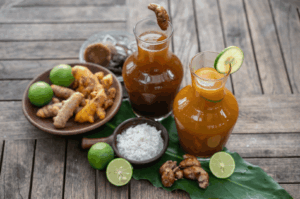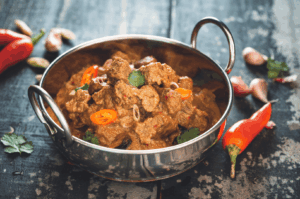
Savoring Indonesia’s Culinary Diversity
Exploring food in Indonesia is a journey through the heart of Asia’s food guide, offering some of the best food in Asia. With over 17,000 islands, Indonesia’s cuisine blends regional identities, age-old techniques like stir frying, and bold spices, flavors, and textures. Whether at a Jakarta night market or a Bali temple feast, each dish reflects local traditions shaped by geography and history.
Central to Indonesian eating is nasi goreng, a popular and famous fried rice featuring fragrant kecap manis, smoky caramelization, and toppings like egg or crisp shallots. Regional variations—from spicy Balinese to sweeter Javanese—keep this staple exciting.
Satay reigns as street food royalty: skewers of marinated meat grilled over charcoal, served with rich, sweet peanut sauce enlivened with tamarind. Rendang, a slow-cooked beef coconut based curry bathed in coconut milk and aromatic spices like galangal and lemongrass, is a festive favorite.
Regional specialties include Java’s sweet jackfruit stew, gudeg. Many dishes use fish paste to boost umami, especially in condiments and sides. Each island offers unique tastes revealing the soul of Indonesian cooking through its famous dishes and delightful mix of influences.
Discover Authentic Flavours Across Asia's Culinary Landscape
This comprehensive Asia dining guide to Indonesia reveals a culinary culture that celebrates diversity, tradition, and the healing power of food and drinks. Through this vibrant world of food and drinks, Indonesia provides an endless adventure—one best savored with curiosity and an open heart.
Latest Articles About Indonesia
Jamu: Indonesian Herbal Medicine for Modern Well-Being
Across the Indonesian archipelago, a vibrant tradition of herbal healing has flourished for centuries. This is jamu, a cornerstone of Indonesian cultural heritage and a sophisticated system of traditional herbal medicine. Far more than just a refreshing drink, jamu represents a philosophy of balance, a deep connection to nature, and a form of indigenous medicine…
Read MorePadang Beef Rendang: The Complex Process Behind Indonesia’s Most Famous Dish
This post may contain affiliate links. For full transparency, this article may contain affiliate links. To call Padang beef rendang simply a dish is to miss the soul of Indonesian cuisine. This legendary slow-cooked dry curry, a centerpiece of both festive tables and humble meals, has earned its fame as one of the world’s most…
Read More
